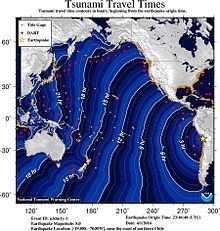Origin time 20:46 CST (UTC-03:00) Depth 20.1 km (12.5 mi) Total damage 2,500 homes damaged Date 1 April 2014 | Magnitude 8.2 Mw Max. intensity VIII (Severe) Location Chile | |
 | ||
Similar 2010 Chile earthquake, 2015 Illapel earthquake, 1960 Valdivia earthquake, 1868 Arica earthquake, 2007 Tocopilla earthquake | ||
The poseidon ensemble 2014 iquique earthquake
The 2014 Iquique earthquake struck off the coast of Chile on 1 April, with a moment magnitude of 8.2, at 20:46 local time (23:46 UTC). The epicenter of the earthquake was approximately 95 kilometres (59 mi) northwest of Iquique. The mainshock was preceded by a number of moderate to large shocks and was followed by a large number of moderate to very large aftershocks, including a M7.7 event on 3 April. The megathrust earthquake triggered a tsunami of up to 2.11 metres (6.9 ft) that hit Iquique at 21:05 local time (00:05 UTC, 2 April). Similar-sized tsunamis were also reported to have hit the coasts of Pisagua and Arica.
Contents
- The poseidon ensemble 2014 iquique earthquake
- Geology
- Earthquake
- Effects
- Aftershocks
- Associated events
- Tsunamis
- References
Geology
A number of mid-sized quakes struck the same area in the preceding weeks. These quakes and the main tremor are associated with the boundary of the Nazca Plate and the South American Plate.
Earthquake
There was a cluster of earthquakes starting from the one occurring on March 16 with a magnitude of Mw 6.7, and a large earthquake had been expected. The 8.2 earthquake was smaller than what was expected, with a rupture of 200 km (120 mi) in length instead of the expected 600 km (370 mi) rupture. The earthquake was felt in Chile, Peru, and Bolivia. The intensity reached intensity VIII (Severe) in Iquique, Chile.
Effects
Four men died of heart attacks and one woman was reportedly crushed to death when a wall collapsed. A loader was crushed by a falling metal structure and died of the injuries afterwards. Around 80,000 were displaced by the event. Electricity and water services were interrupted in the regions of Arica y Parinacota and Tarapacá.
During the aftermath of the earthquake, 293 prisoners escaped from a women's prison in Iquique when a wall collapsed. Many returned voluntarily a short time later, while Chilean soldiers searched for the rest.
According to the Peruvian emergency services, nine people were slightly injured, seven households have been affected, one temple has collapsed and electricity outages in the affected regions of Tacna, Moquegua and Arequipa occurred, which were restored later.
Aftershocks
There were several significant aftershocks above 6.0 magnitude and many more of lower magnitude over subsequent days.
Associated events
Such large earthquakes can have effects far away other than tsunamis. A megathrust quake can shake the entire earth, but causes stronger movement and strain on the entire associated oceanic plate, beyond the few hundred kilometer rupture zone. Though too far to be an aftershock, a 6.0 quake on a thin protruding wedge of the Nazca Plate (Iquique quake shoved this plate) was reported off Panama within 12 hours of the main shock.
Tsunamis
Under advice from the Pacific Tsunami Warning Center, tsunami warnings were issued for the Latin American Pacific coastlines of Chile, Peru, and Ecuador shortly after the earthquake occurred. Chile was subsequently hit by a tsunami of 2.11 m in its northern territories.
The tsunami warning was later canceled for all countries except Chile and Peru within a few hours of the earthquake. The tsunami warning was canceled for both Chile and Peru at around 4:58 UTC on 2 April. Hawaii was under a tsunami advisory for over 13 hours. On April 3 local time, tsunamis were observed in Japan. The tsunami reached 60 centimetres (2.0 ft) high in Kuji, Iwate Prefecture, Japan.
